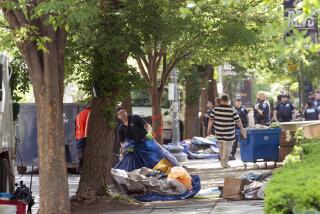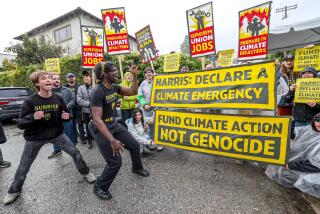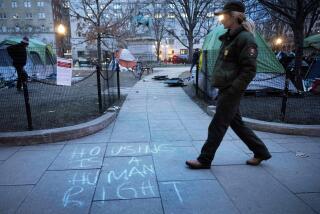Occupy takes protest to street -- the one near Bank of America
This post has been corrected. Please see note at bottom for details.
Occupy D.C. activists, like those in some other cities, are adopting a new tactic. They call it “sleepful protest.”
Over the weekend, Occupy D.C. activists established what they hoped would be a permanent camp outside a Bank of America branch near the White House. There was but one tent -- and it was purely symbolic, with protesters sleeping on the street instead.
Activists say they’re returning to Occupy’s roots.
On Tuesday, Washington, D.C., police cleared the protesters, arresting two of them, including Harris Nicholas Ntabakos, 30.
“I told the officer, ‘I’m not breaking the law,’ ” Ntabakos told The Times, adding that he cooperated with the police. Later in the day -- and back on the sidewalk outside the bank -- Ntabakos pulled a court summons for “blocking passage” out of the back pocket of his pants.
The Metropolitan Police did not immediately respond to request for comment.
Occupy groups in New York and Philadelphia are also adopting the tactic, arguing that sleeping on city streets is protected by the law. Monday night, about 40 protesters slept on the sidewalk by the New York Stock Exchange. Rumors of arrests circulated online, but a spokesman for the NYPD said Tuesday morning that he wasn’t aware of any arrests.
Big banks have attracted renewed attention from the Occupy movement in recent weeks. In March, journalist Matt Taibbi wrote a Rolling Stone article, “Too Crooked to Fail,” criticizing Bank of America. Ntabakos referred to that article as motivating his current protest.
On Friday, Occupy Wall Street hopes to convince people to move their money out of Bank of America and into credit unions.
Many protesters hold Bank of America responsible for kicking families out of their homes through foreclosures. “These are the criminals who started this movement,” Ntabakos said.
The Washington protesters were forced out of a park in February and first made the jump to city streets out of necessity. They now believe that small groups of protesters can stay on city sidewalks without being moved along by the police.
Jeffrey Light, an attorney who represents Occupy D.C. protesters, confirmed that interpretation of the law but said protests must be limited to 25 people. Parks in Washington tend to be governed by federal laws; camping in them is forbidden, but sleeping on city streets is not.
Activists were optimistic Monday afternoon. Nathan Grant, who has been involved with the Occupy movement since last year, said that protesters hope to send “sleeper cells” -- small groups of protesters -- to target other bank branches.
Robert Dilley, another activist, said the camp-out was designed to bring attention to Bank of America’s foreclosure practices. “The banks, which are corporations -- and people I guess -- don’t sleep, but we have to,” he said. “There’s no reason we can’t protest while we sleep.”
Occupy’s D.C. franchise has struggled since its February eviction by the United States Park Police, which is responsible for most of the city’s parks. But over the Easter holiday weekend, two distinct Occupy groups in the city agreed to join forces and hatched the plan to camp outside banks. The activists now say they are excited for the spring.
“This is the beginning of a turning wheel,” Grant said.
[For the record, April 11, 3:20 p.m.: An earlier version of this post incorrectly referred to Harris Nicholas Ntabakos as Harris Nicholas.]
ALSO:
Destined to be great? 13-year-old grabs wheel, saves school bus
Trayvon Martin case: George Zimmerman website solicits donations
Teen births hit new low in U.S., as pregnancy prevention programs pay off
More to Read
Sign up for Essential California
The most important California stories and recommendations in your inbox every morning.
You may occasionally receive promotional content from the Los Angeles Times.










